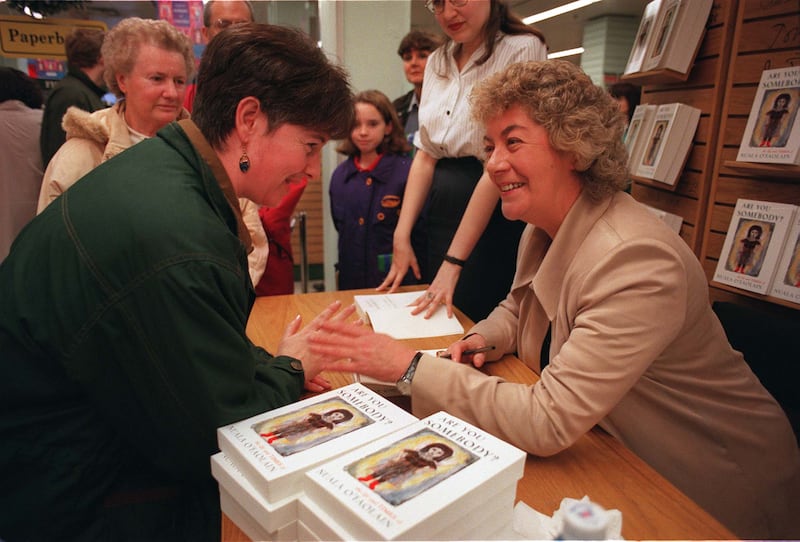In August 1997, less than a year before the Belfast Agreement, the finest newspaper columnist in the Republic, Nuala O’Faolain, wrote in The Irish Times that “Being Northern or Southern is a primary mark, like being male or female, or young or old, or rural or urban, or black or white.”
It was a startling set of comparisons, suggesting as it did that the differences on either side of the Border are as much genetic as geographical. And to many people across the island, this was a deeply contentious, even offensive, idea.
But O’Faolain was raising questions that, after a quarter of a century, have not gone away. Are those of us who live on the island of Ireland essentially, as Irish nationalism has always maintained, all the same?
Are we, as O’Faolain implied and most unionists believe, so different that we can never be the same? Or is the truth somewhere in the middle, that we are, to use that very Irish expression, the same only different?
‘Different currency, same people.’ All-island market offers opportunity and challenges on both sides of the Border
Strong desire for continued British-Irish links after unity, survey shows
How to connect Ireland and Britain after unity? Once mothballed institution may be key
Stark divide on immigration between Sinn Féin voters North and South
The Irish Times/ARINS survey, which is the most comprehensive research project ever conducted into attitudes to a united Ireland, North and South, tells us that there is still no shared answer to these questions.
Those who want unity the most seem to see it is an extension of sameness: the North essentially dissolves into the South. But the survey shows how very far from Irish reality such an assumption remains. Any honest discussion of unity has to start with the acknowledgment of very profound differences.

It is not that there is an Iron Curtain across the Border. Just a few months after O’Faolain’s column appeared, voters in the Republic chose a Northerner, Mary McAleese, as their head of state, suggesting that the divide was hardly as visceral as she intimated.
Since then, we have seen, for example, a Northern Protestant become commissioner of An Garda Síochána and a Southern Catholic representing the workers at Harland and Wolff shipyard. A cross-Border party, Sinn Féin, is the most popular on the island as a whole.
Brexit drew attention to the fact that the Border has become extremely porous, with at least 30,000 people crossing it for work every day by road alone. It was precisely because the sense of physical separation has diminished so greatly that there was such horror at the prospect of its return.
And yet, if O’Faolain was not right, she was not entirely wrong. Northern or Southern might not be as fundamental a division as she suggested, but it is far from meaningless.
It may be that the sense of distance reflects a deeper instinct, a feeling that Irish unity continues to exist in a kind of Dreamtime where real problems and uncomfortable animosities do not need to be confronted
A century of partition has ensured that people on either side of the Border have had very different political experiences. Yet partition didn’t just create disparities – it was itself rooted in historic dissimilarities: different mixes of religious identities, different balances between industry and agriculture, different patterns of urban development and migration.
And intersecting with ideas of Northern and Southern were, of course, sectarian antagonisms. North and South have never been merely geographical descriptions.
For Southerners, some Nordies are more alien than others (and vice versa).
In a major survey published by the ESRI in 1979, a startling 74 per cent of Southerners declared themselves antagonistic to “Northern Protestants”, with just 7 per cent claiming to be favourably disposed towards them.
How much this has really changed remains an open question. The ARINS survey does not ask the question so bluntly, but a very rough proxy might be the finding that respondents in the Republic overwhelmingly “feel very distant” from the Democratic Unionist Party (DUP).
Given that, like it or not, the DUP represents very many of the people that Southerners want to unite with, it is striking that, on a Richter scale of estrangement, where 5 represents a sense of absolute alienation, the average Southerner awards them a 4.6.
It may be that this sense of distance reflects a deeper instinct, a feeling that Irish unity continues to exist in a kind of Dreamtime where real problems and uncomfortable animosities do not need to be confronted.
There are very good reasons for such a feeling. The Belfast Agreement makes it clear that there can’t even be a Border poll until there is evidence that a majority in Northern Ireland might wish to vote to leave the UK. The ARINS survey throws a large bucket of ice over heated expectations that this condition is anywhere near being met.
A mere 27 per cent of people in the North say they would vote for a United Ireland. That’s not much more than in 1978, when a large study by Queen’s University Belfast found that 22 per favoured Irish unity in some form.
It’s striking, indeed, that when it comes to this whole question, the more things change, the more they seem to stay the same. In the ESRI survey of 1979, 68 per cent of respondents in the Republic favoured some form of a United Ireland. Now, in the ARINS study, it’s 66 per cent.
Even the doublethink remains constant. In 1979, asked if they would pay higher taxes in return for unity, 51 per cent of Southerners said they would not. Recent polling shows that this reluctance to put their money where their mouths are has scarcely shifted – and the ARINS survey shows that most Southerners would not even make minor cost-free concessions like changing the national anthem in return for unity.
There is in fact an even more remarkable continuity: the ability of Southerners to want to unify with a place they don’t care all that much about. In 1979, asked how interested they were in Northern Ireland, fewer than half (48 per cent) of Southern respondents said they were either “very” or “quite” interested.
Back then, it might have been possible to explain this odd disjunction by saying that it was, after all, grim up North. The Troubles had been grinding on for a decade. The news was relentlessly awful. A day trip to Belfast was not most Southerners’ idea of fun.
But what’s the excuse now? A curious foreigner might assume that, after nearly 25 years of peace, such contradictions would not be possible.
And yet, the ARINS survey has shown that support for unity in the Republic does still not necessarily involve any particular interest in Up There.
Two-thirds of people in the Republic say they have no friends in Northern Ireland, more than 80 per cent say they have no relations there, and more than half have not travelled across the Border in the past five years.

What’s startling is that this lack of real contact makes very little difference to the desire for unity – 64 per cent of those in the South who have “weak connections” with the North nonetheless want to unify with it. Claiming the fourth green field does not seem to imply a duty to cultivate it.
What these findings suggest is that Southerners have not taken their own Constitution all that seriously. It is now nearly 25 years since over 94 per cent of voters in the Republic endorsed a rewriting of Articles 2 and 3 to drop the claim that Northern Ireland was part of “the national territory”.
What replaced this claim is the aspiration “to unite all the people who share the territory of the island of Ireland, in all the diversity of their identities and traditions”. The order of priority is clear: Irish unity is about people first, and then about the territory.
Yet, a quarter of a century on, it is not at all obvious that this unity of people is what most Southerners mean by a United Ireland. Territory, in an almost abstract formulation of adding six to 26, remains the touchstone.
Should we, then, just forget about the whole thing? For good or ill, we can’t.
The dominant idea of unity is still much more akin to adding an extension to the existing house rather than constructing a new kind of communal living space. And even the plans for the extension are very roughly sketched.
Perhaps this lack of thought about what unity might mean is merely a function of a reluctance to really think about the issue at all. Just 15 per cent of voters in the South and 9 per cent in the North list “achieving a United Ireland” among their top four political priorities. Ironically, this is one of the great similarities between the two sides of the Border – neither has any great sense of urgency about unification.
A United Ireland is, then, a relatively low priority on the island as a whole, has nowhere near majority support in Northern Ireland, and exists for many of its supporters in the South as an aspiration not worth much inconvenience.
Should we, then, just forget about the whole thing? For good or ill, we can’t.
Firstly, the people in Northern Ireland who do want unity have the right to be listened to. Neither indifference nor vague but consequence-free protestations of fellow-feeling are adequate responses to their legitimate aspirations.
Secondly, in spite of all the continuities, some big things are changing. Both Brexit and internal demographic transformations mean that the ground is shifting. The UK is in a potentially existential crisis and Northern Ireland is no longer the entity it was created to be: a securely Protestant enclave.
Third, the ARINS survey shows a lot of fluidity and – whisper it – open-mindedness in the North. The proportion of “don’t knows” on the national question is getting up towards one in five, making this group the one that may ultimately decide the future of the island.
This is not necessarily the “don’t know” of “can’t be bothered”. It’s a much more fertile embrace of possibilities that are not yet fixed. This growing constituency also deserves to be engaged generously on what kind of collective future it might want to be part of.
Fourth, and very much related to this fluidity, is the question of a common European identity. Northern Ireland has been taken out of the EU against its will. That reality is not going to go away and it can’t be disentangled from the political future of the island as a whole.
Finally, the survey does show a growing consensus across both the North/South and nationalist/unionist divides that a Border poll should happen over the next decade. And a desire to know what people would actually be voting on. Nobody wants another Brexit-style referendum in which false promises and inflated rhetoric crowd out rational deliberation.
[ Stephen Collins: Irish unity is a dangerous and distracting mirageOpens in new window ]
If a Border poll is going to happen, it will be crucial that the proposition is not just a slogan. It has to come with a detailed political and economic plan.
And it has to happen after, not before, a sense of shared space has become much more real than it is now. We have to be honest: neither the North nor the island as a whole is that kind of space yet.
The North still needs reconciliation, not least through a genuine process of dealing with the legacy of the Troubles. The South still needs to understand that an arranged marriage with a partner you have barely met is not a promising prospect.
A full archive of all articles in the series is available here North and South – The Irish Times














